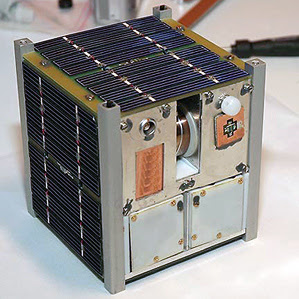Planet Labs hitches rides on commercial rockets made by the likes of Orbital Sciences (ORB) and SpaceX, and has its devices ride as secondary payloads to larger, more expensive satellites.
CubeSats can take pictures, perform science experiments, and communicate with Earth. They just do so way cheaper than traditional gear by playing off increasingly powerful consumer electronics and free software, such as the Linux operating system.
Planet Labs aims to provide frequent snapshots of the planet, allowing users to track changes—from traffic jams to deforestation—in close to real time.
Planet Labs’ satellites will use moderate resolution, making out objects three to five meters wide. But thanks to the sheer number of satellites, the fleet should be able to take more frequent snapshots of the globe.
Planet Labs plans to launch a constellation of Earth-imaging satellites, each consisting of one or more CubeSat units like the one shown here.
There they will orbit at an altitude of 400 kilometers, powered by solar panels.
The satellites will send their images to at least three ground stations—two in the U.S. and one in the U.K. The data will be processed and uploaded for use by customers almost immediately. “If an event happens, like a fire, we have fresh imagery … to understand what’s happening,” says Schingler.
The satellites, which have no propulsion systems, should stay in orbit for two to five years before losing speed to atmospheric drag so that they fall toward Earth and burn up, the company says.
SOURCES – Planet Labs, Business Week
If you liked this article, please give it a quick review on ycombinator or StumbleUpon. Thanks

Brian Wang is a Futurist Thought Leader and a popular Science blogger with 1 million readers per month. His blog Nextbigfuture.com is ranked #1 Science News Blog. It covers many disruptive technology and trends including Space, Robotics, Artificial Intelligence, Medicine, Anti-aging Biotechnology, and Nanotechnology.
Known for identifying cutting edge technologies, he is currently a Co-Founder of a startup and fundraiser for high potential early-stage companies. He is the Head of Research for Allocations for deep technology investments and an Angel Investor at Space Angels.
A frequent speaker at corporations, he has been a TEDx speaker, a Singularity University speaker and guest at numerous interviews for radio and podcasts. He is open to public speaking and advising engagements.


